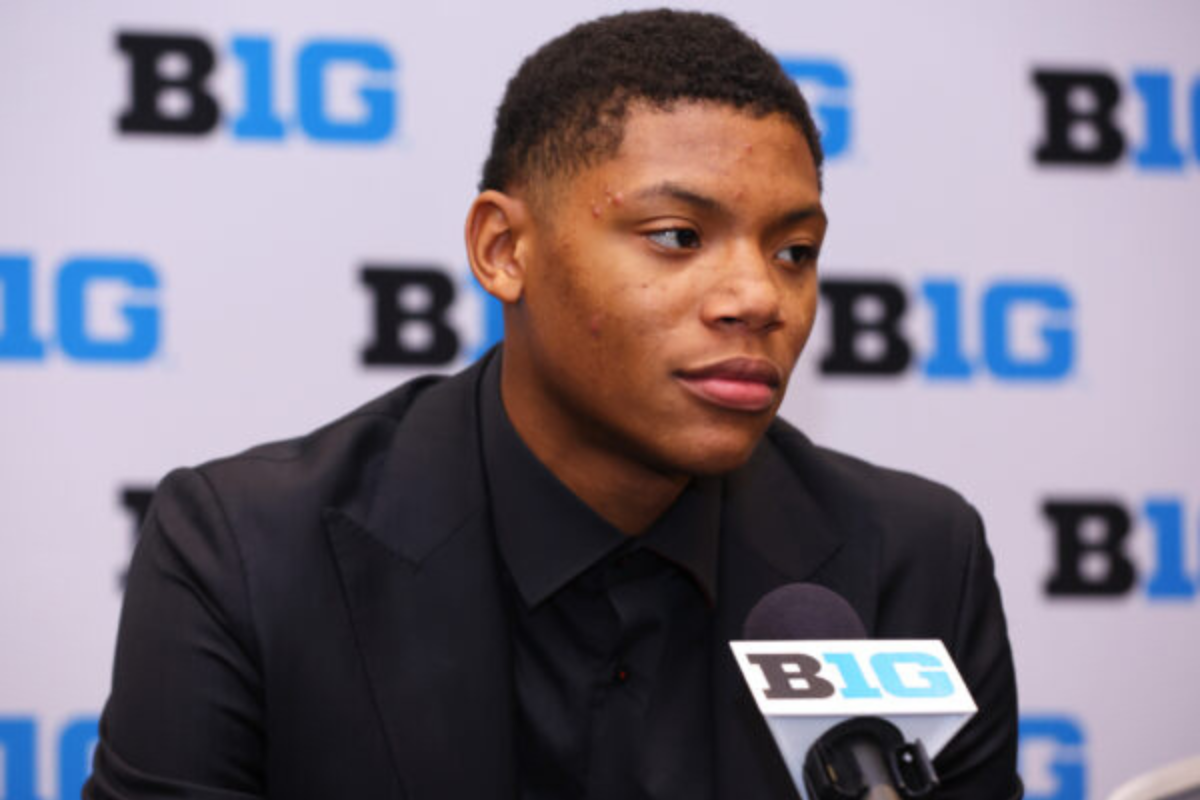
Imago
Oct 3, 2024; Rosemont, IL, USA; Rutgers guard/forward Ace Bailey takes a question at the podium during the 2024 Big Ten Mens Basketball media day at Donald E. Stephens Convention Center. Mandatory Credit: Melissa Tamez-Imagn Images

Imago
Oct 3, 2024; Rosemont, IL, USA; Rutgers guard/forward Ace Bailey takes a question at the podium during the 2024 Big Ten Mens Basketball media day at Donald E. Stephens Convention Center. Mandatory Credit: Melissa Tamez-Imagn Images
There was something unusual about Ace Bailey’s post-draft moment. The Utah Jazz had just landed themselves a potential star with the No. 5 pick – a 6’8″ Rutgers standout who averaged 17.6 points and showed flashes of brilliance. But as he sat down with ESPN’s Monica McNutt, something felt incomplete.
Watch What’s Trending Now!
While the other draftees basked in family hugs. Ace Bailey sat alone in the interview. His parents were right there in the building but never made it on camera—which, considering draft night’s whole thing is crying relatives and awkward dad handshakes, felt like serving a cake without frosting. Even weirder? This wasn’t some random glitch. Bailey’s camp had already raised eyebrows by ghosting workouts with Utah (and Philly) pre-draft, fueling whispers he’d rather land on the East Coast. Yet here he was, Jazz hat on head, family MIA on screen and vibes flatter than a Salt Lake sunset.
Did ESPN’s producers forget to cue his parents? Did agent drama finally spill into the spotlight? Or did a 19-year-old just realize he’s now contractually obligated to figure out what a “winter in Utah” feels like? We may never know. But for a kid whose scouting report raises “maturity questions,” he didn’t exactly deliver the PR rebound he needed.
ADVERTISEMENT
Ace Bailey looks pissed and he was the only one doing the interview alone without his family
I don’t like him
— EuropaLeague🏆 (@SpursD22) June 26, 2025
Silver lining? Utah’s wide-open wing rotation means Ace Bailey could thrive—assuming everyone moves past the interesting choice to draft a guy who’d rather be in Brooklyn. Either way, Jazz fans now have two projects: developing their lottery pick, and figuring out how to Photoshop his family into draft night photos.
ADVERTISEMENT
How Ace Bailey’s Agent Shaped an Unusual Draft Journey
Ace Bailey’s unconventional path to the NBA draft can’t be discussed without mentioning Omar Cooper. He’s the agent who orchestrated one of the most debated pre-draft strategies in recent memory. Cooper, a relatively unknown figure in NBA circles, took a high-risk approach. He had Bailey skip workouts with multiple lottery teams—including the Jazz, who drafted him anyway.
The move baffled scouts and executives. Most top prospects jump at every chance to impress teams picking in the top five. Even NBA veterans like Paul George weighed in. He said: “You’re not in a position to be making those demands. Make it to the league first. It’s definitely the people around him. I’m not sure who is advising him, but their approach doesn’t seem to be the right one.”
ADVERTISEMENT
Cooper’s logic seemed clear. He wanted to steer Bailey toward preferred destinations—ideally East Coast teams where playing time and marketing might be brighter. But the execution was messy. Skipping workouts with Philadelphia (No. 3) and Charlotte (No. 4) risked millions. Sliding just a few spots can cost a player eight figures.
When Utah called Bailey at No. 5, the tension was palpable. His interview felt more like a press conference than a celebration.
Cooper’s track record added fuel to the skepticism. His son, Sharife Cooper, left Auburn early under his guidance but has since bounced around pro leagues overseas. Then there were the odd reports about Cooper seeking payment for Ace Bailey’s interviews during the college season, a move that rubbed media and teams the wrong way. It all painted a picture of an agent playing hardball without the usual leverage.
ADVERTISEMENT
Now, the Jazz get to work with a clearly talented player who might’ve been distracted by off-court noise. The good news? Utah’s development staff has turned raw prospects into stars before. The bad? They’ll need to undo some questionable advice along the way. If Ace Bailey thrives, Cooper’s gamble might look genius. If not, this whole saga will be a cautionary tale about overthinking the draft. Either way, Utah’s patience—and Bailey’s adaptability—will be tested.
ADVERTISEMENT
ADVERTISEMENT
ADVERTISEMENT

